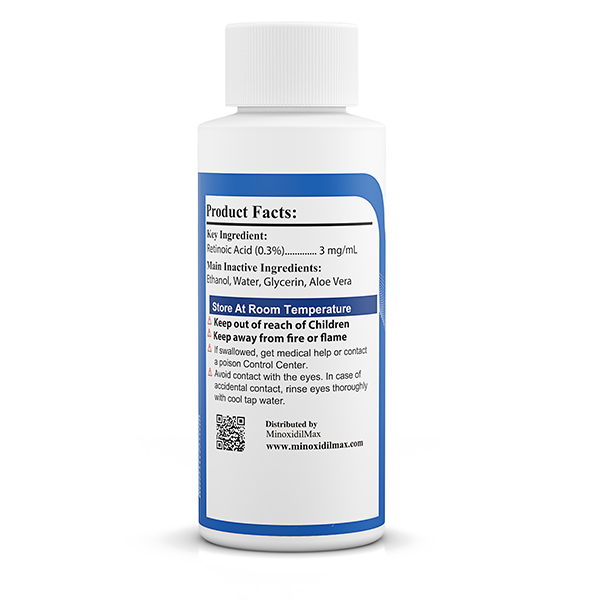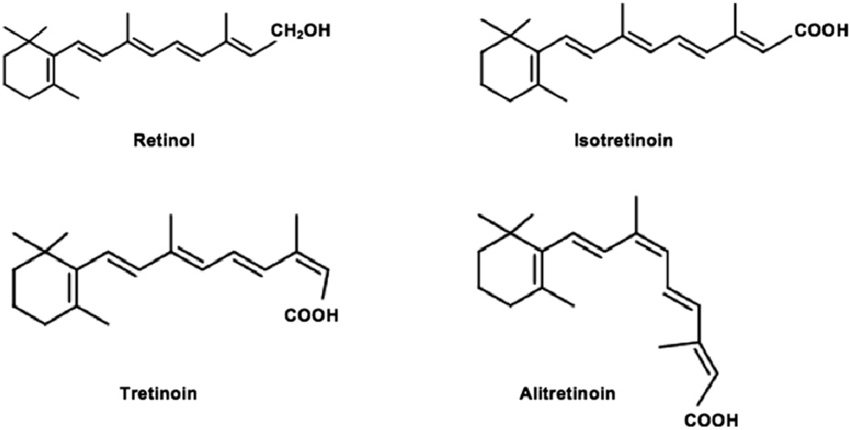RaDerma contains 0.3% retinoic acid (tretinoin), which is very high for most applications. Thus it requires dilution before use in most cases.
It can be mixed with other hair loss treatment products to enhance their effectiveness. For example, 5 ml of 0.3% retinoic acid (RaDerma) can be mixed with 60 ml of 5% minoxidil solution to make a solution with 0.023% retinoic acid and 4.6% minoxidil.
You can easily convert any minoxidil solution to a retinoic acid containing solution with this product.
Retinoic acid: 0.3%
Volume: 60 ml.
Product comes with a dropper for application.
Note: This product does not have any minoxidil. If you need a premade minoxidil and retinoic acid solution, you can check out


1. What is Retinoic acid?
Retinoic acid, also called tretinoin (see structure in the question 4 below) has been used for decades as Retin-A® in the treatment of acne. More recently it is widely used as a treatment for fine wrinkles in the skin. It works essentially as a chemical peel by altering the follicular epithelium (the outer layer of skin) so that it doesn't keratinize (form a hard compact layer). It also stimulates new blood vessels in the skin, giving skin a rosy appearance, fading age spots, and reducing precancerous skin spots called actinic keratosis.
.
2. How to use RaDerma to convert a minoxidil solution to a retinoic acid containing solution?
The common retinoic acid concentration used in a minoxidil product ranges from 0.01% to 0.025%.
To make 0.023% topical retinoic acid & minoxidil solution: Add 5 ml of 0.3% retinoic acid to 60 ml of any minoxidil solution and shake the mixture for 10 seconds.
To make 0.01% topical retinoic acid & minoxidil solution: Add 2 ml of 0.3% retinoic acid to 60 ml of any minoxidil solution and shake the mixture for 10 seconds.
Because the volume of retinoic acid solution added to the minoxidil solution is relatively small, the concentration of minoxidil and any other ingredients such as azelaic acid or finasteride in the original minoxidil product is not affected much (< 10%), and the change can be ignored.
3. Can I use this product on its own?
For hair loss treatment, it is best to mix it with a minoxidil solution as described in Question 2 above. For another example, 5 ml of this solution mixing with 60 ml of Dualgen-15 results in a solution with 13.8% minoxidil, 4.6% azelaic acid, 0.025% retinoic acid.
For acne and wrinkle treatment, retinoic acid can be used by itself. However the concentration is recommended to be no higher than 0.1%. To make 0.1% retinoic acid, 30ml of this solution can be mixed with 60 ml of PG Free Solvent.
4. What are the other names for Retinoic acid?
Retinoic acid also called tretinoin, all-trans-retinoic acid, Vitamin A acid, Retin-A®, Atralin®, Avita®, Renova®, Tretin-X®. Do not confuse it with Isotretinoin (brand name Accutane). Isotretinoin to Tretinoin (retinoic acid) is like someone's left hand to right hand structurally. They look almost identical, but you can never overlap them.

5. Why is Retinoic acid added to minoxidil?
A: Minoxidil has to be absorbed by the scalp in order to be effective. Minoxidil itself cannot penetrate the scalp . That is why delivery vehicles such as propylene glycol (PG) or glycerin or dimethyl isosorbide (DMI) are used in all minoxidil products. The addition of retinoic acid can further help minoxidil penetrate the skin and reach hair follicles and thus enhance the effectiveness of minoxidil.
According to a study by Shin et al, when 5% minoxidil is mixed 0.01% retinoic acid (tretinoin), it can be used once a day and achieve equivalent results as 5% minoxidil twice daily usage. (See the study at the end of this FAQ).
6. What are the common side effects of Retinoic Acid (tretinoin)?
The most common side effects are scalp itchiness, skin peeling, redness, dry skin, flaking or dandruff of the scalp. Retinoic acid also makes the scalp sensitive to sun burn.
7. How can I reduce the side effects of Retinoic acid?
a). Use retinoic acid at night.
b). Avoid using the product after a hot shower.
c). Use the product progressively to let your scalp build tolerance. You can start with once every other night, then move to once every night, and finally increase to twice a day.
d). Add steroid such as 0.01% Fluocinolone or 0.1% hydrocortisone or to the retinoic acid minoxidil solution.
e). Use ketoconazole anti-dandruff shampoo such as Hair Covet Restoration shampoo.
8. Will I have shedding when starting Retinoic acid?
A small percentage of people may experience an initial increase of hair loss (shedding) at the onset of treatment similar to the use of minoxidil. However, the shedding resolves with time. (Read minoxidil shedding here)
9. Why is retinoic acid recommended to be used at night?
Retinoic acid is degraded by strong light, so there is no benefit to using it during the day, when the bright light will render the medication ineffective.
10. Can I still use minoxidil solutions with retinoic acid, if I like to be out in the sun or get a lot of sun exposure on my job?
The activity of retinoic acid is affected by direct sunlight as mentioned in the question 7. Therefore, if you are in the sun a lot, it is best to use retinoic acid only at night and in the morning use solely the 5% minoxidil. In addition, Retinoic acid also increases your sensitivity to the sun. Therefore if you apply any solution that contains retinoic acid in the morning, avoid direct sun exposure to the scalp or apply sunscreen or wear a hat.
Article shows the addition of 0.01% retinoic acid to 5% minoxidil doubles the effectiveness of minoxidil.
RESULTS: The two groups showed equivalent results. See the complete article .
PRODUCT REVIEW
CUSTOMERS WHO VIEWED THIS PRODUCT ALSO VIEWED
Reviews